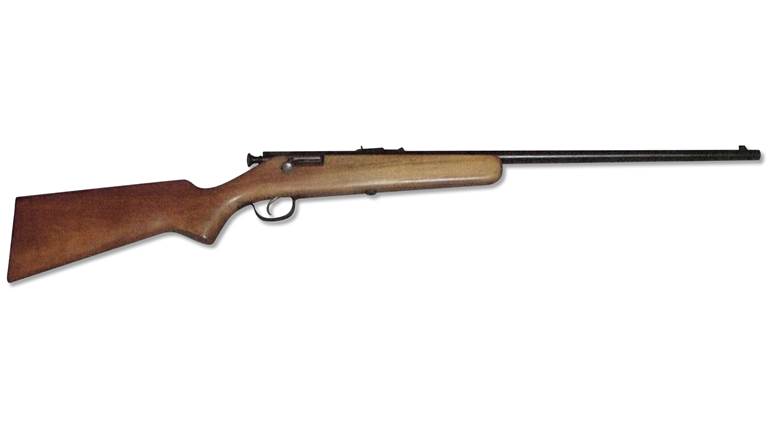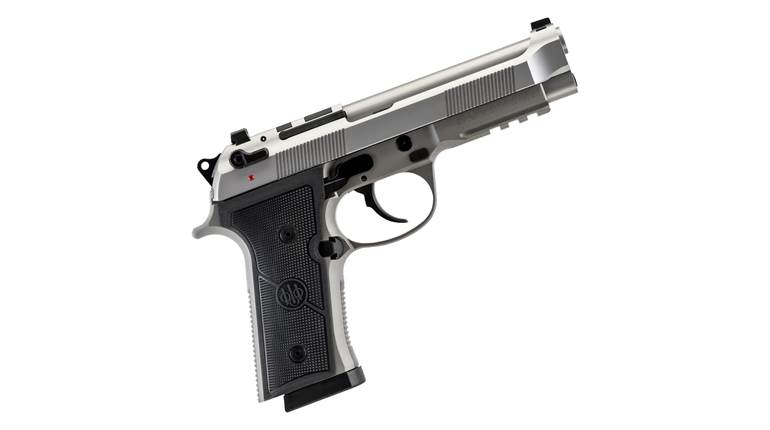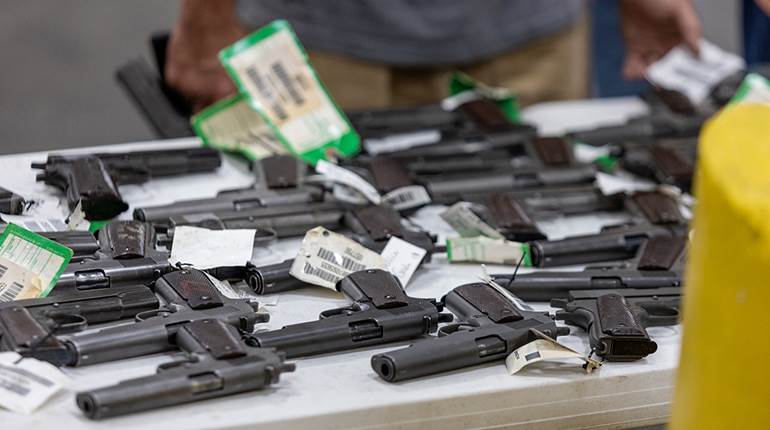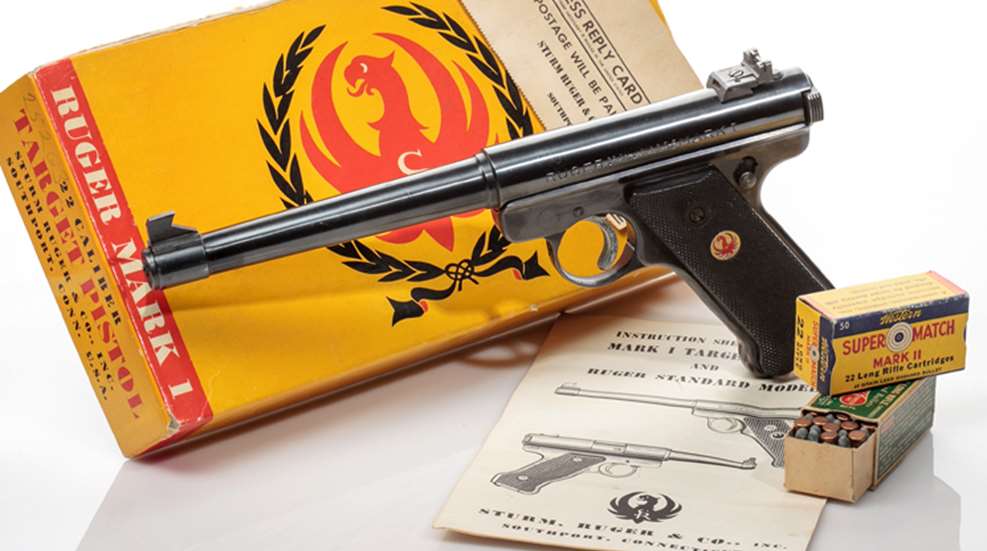
Sturm, Ruger & Co., Inc., was formed in January 1949, and production was soon underway for the fledgling company’s sole product, a .22-cal. pistol designed by company co-founder, William B. Ruger. The first shipment of Ruger .22 pistols was on Oct. 6, 1949. By year’s end, 1,138 pistols had been shipped, and Ruger had a backlog of 5,000 unfilled orders by February 1950. By the summer of that year, Ruger was turning out 900 pistols per month. With a backlog of 9,000 orders, Ruger’s production goal became 1,000 pistols per month. It’s safe to say that, after only a year, Sturm, Ruger & Co. had become an established firearm manufacturer.
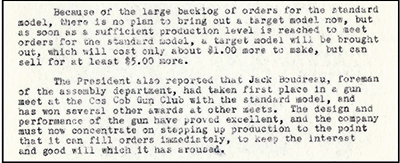 Even before the first Ruger pistol was shipped, though, Bill Ruger was considering increasing the product line to include a target pistol. Ruger employee John “Jack” Boudreau had proven Ruger’s .22 “plinker”—with a little fine-tuning—could compete with other manufacturers’ more expensive target models. Boudreau acquired his Ruger pistol in September 1949 and had won several matches with it before the end of the year. Ruger hired him in 1949 as operations began at the Southport, Conn., factory. Boudreau had been a successful target pistol shooter since 1932. He was also a self-taught pistolsmith and he held a patent for an Olympic-style Free pistol of his own design. He believed there was a market for a target version of the Ruger .22 pistol. Bill Ruger agreed.
Even before the first Ruger pistol was shipped, though, Bill Ruger was considering increasing the product line to include a target pistol. Ruger employee John “Jack” Boudreau had proven Ruger’s .22 “plinker”—with a little fine-tuning—could compete with other manufacturers’ more expensive target models. Boudreau acquired his Ruger pistol in September 1949 and had won several matches with it before the end of the year. Ruger hired him in 1949 as operations began at the Southport, Conn., factory. Boudreau had been a successful target pistol shooter since 1932. He was also a self-taught pistolsmith and he held a patent for an Olympic-style Free pistol of his own design. He believed there was a market for a target version of the Ruger .22 pistol. Bill Ruger agreed.
Ruger and Boudreau conferred on the essentials needed to produce an economically priced target pistol based on Ruger’s original design. Their first thought was to offer a type of “conversion unit” in the form of a barreled receiver with a heavy, tapered barrel and target sights. This unit would interchange with the fixed-sight, barreled receiver with 4¾" barrel, standard on the Ruger pistol. Though manufactured to exacting tolerances, they found some receivers would not “match up” to an alternate frame without some hand fitting. In addition, an upper replacement unit would not address the standard production trigger. That proposal was never implemented; instead, a new model was planned.
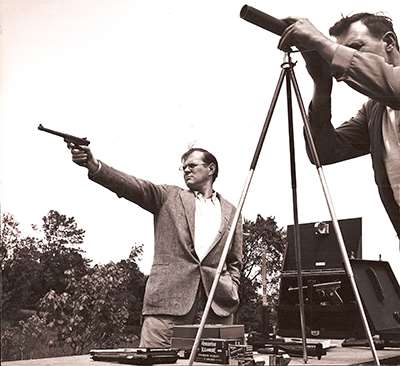
Sighting was one of the main concerns for developing a target pistol. A modified Lyman 57 peep sight was one option, although fully adjustable, it was bulky. In April 1950, an experimental .22-cal. target pistol was assembled for initial testing and evaluation. A regular-production receiver tube, with the period square ejection port, was utilized. The barrel was a heavy, tapered 67⁄8" with a machined band to attach the front sight blade. Sights were an adjustable Micro rear and a Patridge-style, undercut blade for the front. The barreled receiver was fitted to a regular-production grip frame assembly with checkered, hard-rubber stock panels. The trigger was fitted with an adjustable stop. Serial numbers (at that time) had reached just more than 3800. This was the first target version of Ruger’s original pistol. All markings were the same as on production pistols, including the serial number, which was 3815. The fully assembled pistol, weighing 42 ozs., with excellent balance and handling, was to be the pattern for the new Ruger Target pistol.
Prototypes were assembled and serial numbers were assigned, beginning with X1 and ending with X32, however all 32 numbers were not used, and serial numbers were hand-stamped. Number X4 was assembled and test fired on July 24, 1950, X3 on July 26, 1950, and X13 in September of 1950. X5 was sent to NRA for evaluation and photography. The date it was shipped is not available, but a photograph of serial number X5 is featured on p. 68 of the December 1950 issue of The American Rifleman, “Dope Bag” section. Number X32 was never assembled. Factory records list X32, “for museum.” Examination of the pistols (the few I have seen) shows some variances from one to the other:
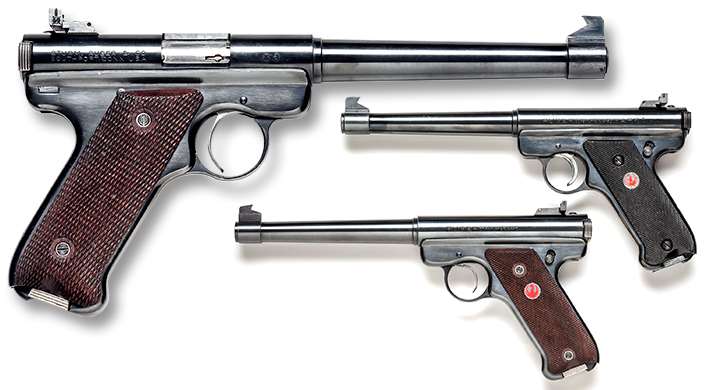
The grooved, aluminum (regular production) triggers were substituted, in numbers X3 and X13, with smooth, unfinished, handmade, steel triggers.
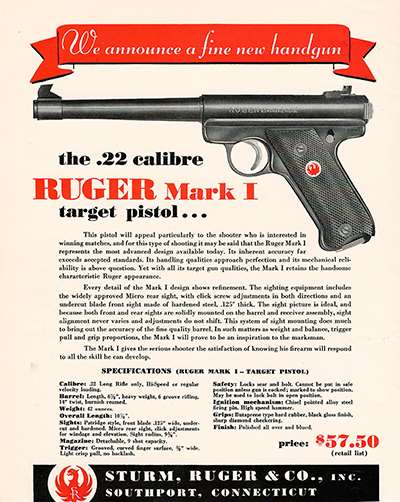
At least two pistols were fitted with checkered, hardwood stocks with aluminum stock screw escutcheons. All prototype pistols have the red Ruger logo medallion in the left panel.
Barrel length on X3 is 6 5⁄8".
Barrel length on X13 is 6 7⁄8".
Barrel crowns vary.
The barrel on number X5 is locked in the receiver by a small hex head screw.
All are fitted with an adjustable Micro rear sight. At least one has a narrower base, set farther back, and does not have the “hinge steadying spring” or the indentation for the spring.
Number X5 was returned to the factory in 1951. According to Ruger Pistols & Revolvers: The Vintage Years 1949-1973 by John C. Dougan, a factory memo, dated Feb. 24, 1959, listed numbers X5 and X32 as being in the factory collection as “barrel & receiver assemblies” only.
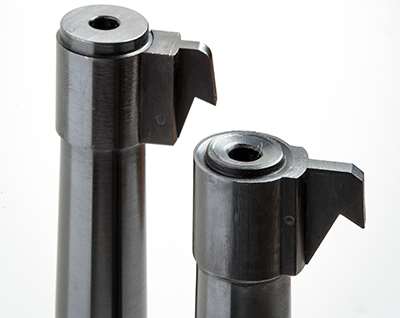
Major General Julian S. Hatcher gave the new pistol a favorable review in the December 1950 Rifleman. Ruger also placed a full-page advertisement on the inside front cover of that issue introducing the new pistol. Shipments of the Mark I Target pistol began in January 1951 at a retail cost of $57.50. Serial numbers began with number 15000. At that time Ruger began to number different models in serial number “blocks.” Before the introduction of the Mark I Target, Ruger’s .22 pistol did not have or need a title; it was simply the Ruger Pistol. Hatcher referred to the original offering as the Sport Model, though it was by then (January 1951), officially, the Standard Auto.
The new Mark I Target Pistol was offered with a 6 7⁄8" heavy, tapered barrel, with target sights, and an improved trigger with built-in stop. An early factory brochure, forecasting what would become decades of success, read: “Superb trigger pull will invariably result in improved scores, as many outstanding pistol experts have already discovered.”












